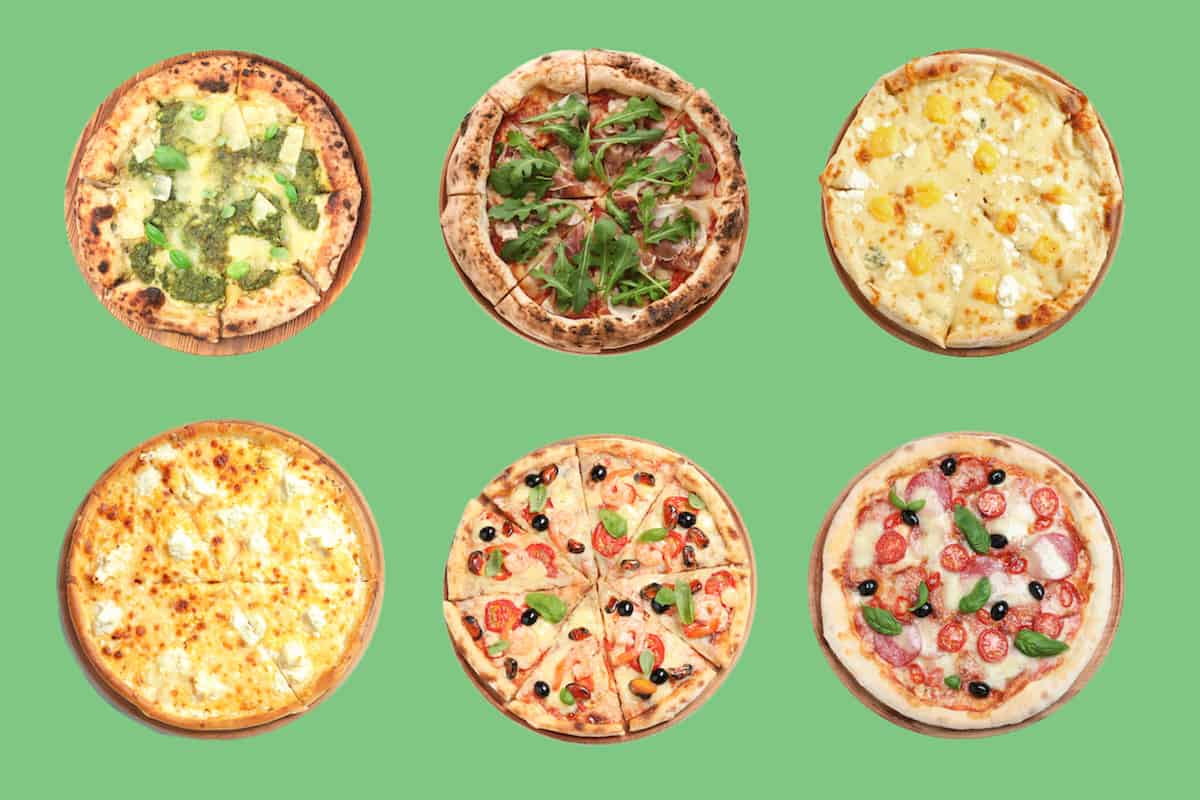Thin, Thick, or Stuffed? Different Pizza Crusts to Try

When it comes to pizza, the crust is often seen as the vessel to carry the sauce, cheese, and toppings. But in reality, the crust is what makes or breaks a pizza!
There are many pizza crust options beyond your typical thin, deep dish, or stuffed crust.
Today, I’ll go through 10 of the most popular types of pizza crusts. Read on to see if I covered your favorite!
10. Cauliflower Crust
While not everyone considers cauliflower a “true” pizza crust, it’s an alternative that’s had the world abuzz since it first gained popularity in the late 2000s.
To make cauliflower crust, the edible white flesh (commonly referred to as the curd) is grated very finely and combined with eggs, spices, and cheese to create a dough.
It’s then shaped into a flat circle, usually the size of a personal pizza.
Cauliflower crust is great for those who don’t eat gluten or are looking to cut down on carbs.
While it’s not an identical match to true pizza crust in texture, it crisps up well and has a nice tender middle.
Cauliflower has a very mild flavor, so there won’t be any unwanted aftertaste if you opt for a cauliflower crust pizza.
9. Pan-Fried Crust
Pizza is usually made in an oven, right? Right. But sometimes, it’s made on the stovetop inside of a pan. And once you try it this way, you may just never go back!
First, pizza dough is pressed into an oiled skillet (I’ve found my cast iron skillet to work well when making pan-fried pizza in the past).
Once it’s been cooking for a bit, the sauce, cheese, and toppings are added.
By the time the pizza is done, the crust has become caramelized and perfectly charred.
Pan-fried crust is one of the more underrated crusts on this list.
If you love a chewy, crunchy crust that’s almost a bit sweet in the extra caramelized areas, this crust will be right up your alley.
Plus, a pan-fried pizza often cooks a lot quicker than an oven-baked pizza.
Try this method next time you’re low on time and craving some really good pizza!
8. Stuffed Crust
In all my years of life thus far, I’ve never eaten something and said, “Wow, I wish this had less cheese on it!”
I think that’s the philosophy behind the stuffed-crust pizza. Sometimes, more is simply better!
Stuffed crust is usually a regular crust on the bottom of the pizza, but the outer edges are rolled and filled with cheese and sometimes other toppings like meat or veggies.
The stuffed crust also acts as a barrier to keep all the cheese and toppings in the middle contained.
Some pizzerias even take it further and brush the crust with butter and garlic, so no square inch of crust goes uncovered.
As you probably already know, most popular pizza chains now offer some variation of stuffed crust pizza.
It’s safe to say that this decadent crust is here to stay for the foreseeable future.
7. Sicilian-Style Crust
Sicilian-style crust is more or less focaccia bread. Focaccia is a thick and fluffy bread often cut into rectangular slices.
Add tomato and cheese to the top, and you’ve got yourself a Sicilian-style pizza!
This type of crust really makes a Sicilian pie what it is.
It is crispy on the outside yet soft and chewy on the inside, making for a satisfying textural contrast in each bite.
Sicilian-style crust is usually made with bread flour and left to rise until it’s doubled in size, which gives it its iconic airy interior.
6. Hand-Tossed Crust
Hand-tossed crust is like that one friend you’ve had since elementary school – it’s classic, trustworthy, and you always know what you’ll get!
For all its great qualities, hand-tossed crust is definitely one of the hardest pizza doughs to prepare at home.
Instead of rolling it out, the dough is stretched and tossed by hand until it creates a large circle.
The process of hand-tossing allows the dough to be stretched more and develop strands of gluten, making it chewier than your average crust.
In addition, tossing dough by hand makes for a thin, airy texture that is also successful in holding multiple toppings without sagging or getting soggy.
Famous pizza types like Brooklyn-style and Neapolitan-style both rely on the hand-tossing method for their iconic chewy crust.
5. Flatbread Crust
The aptly named flatbread crust is an unleavened, thin crust. In fact, it’s probably the thinnest pizza crust on our list.
Flatbreads originated in ancient Egypt and are quite popular in Mediterranean and Middle Eastern cuisines. They’re also one of the most popular pizza crusts in America.
Flatbreads are made with flour, salt, and water. With a short ingredient list and such a thin crust, it’s ideal for those in a time pinch.
Flatbread is a thin, light crust with enough crispiness to keep from getting soggy when toppings are added.
4. New York-Style Crust
New York-style crust is typically hand-tossed, meaning it will be chewy with crispy edges.
It is also unique because of its size. It’s hand-tossed until it’s large and thin, much larger than your average hand-tossed pizza.
This is so that each slice is large enough to be easily folded to take on the go. After all, New Yorkers are always going somewhere!
Since it is hand-tossed, the New York-style crust is fairly thin and sturdy, allowing for plenty of pizza toppings or extra cheese.
3. Deep Dish (Chicago-Style) Crust
Deep dish, or Chicago-style crust, is made with more butter or oil than your typical crust.
The result is a rich, velvety crust and doughy (but not undercooked) interior.
Deep dish is the thickest crust out there, rivaled only by Sicilian-style crust.
It’s partially baked before toppings are added, and baking is finished once everything is in place.
Chicago-style pizza is usually topped with tomato sauce instead of having the sauce at the bottom, so the bottom crust is even crispier than your average pie.
Deep dish crust is popular for its super supportive structure, which holds in as much cheese, sauce, and toppings as your heart desires.
2. Thick Crust
When it comes to pizza, most people are in one of two camps: thick crust or thin crust.
Thick crust pizza, of course, is thick and has a soft, doughy texture.
This makes for a chewier pizza than your typical flatbread or even deep dish crust.
Similar to a Sicilian-style crust, it’s more like an airy, fluffy bread than a classic pizza crust.
Thick crust will vary depending on which pizzeria you’re ordering from. There’s no standard size that the crust has to be in order to pass as true “thick crust.”
For those looking for a truly indulgent and filling pizza experience or who love the crust and can’t get enough of it, the thick crust is the way to go!
1. Thin Crust
We’ve reached the pièce de résistance, the crust to rule all crusts – the thin crust pizza!
I think it’s safe to say that thin crust may just be the most well-known pizza crust type out there.
As you can tell by its name alone, the thin crust’s defining characteristic is its thinness.
Thin crust pizza is usually baked at high temperatures, which makes the crust crisp up quickly.
Since it’s so thin, the pizza is crispy throughout and not quite as chewy as other thicker options.
It’s also much lighter than a deep dish or thick crust pizza, meaning you’ll have plenty of room in your stomach for all those toppings.
Thin crust is a humble team player – it allows the sauce, cheese, and toppings to be the stars of the show.
From Neapolitan to Roman to Margherita, some of the most beloved pizzas in the world begin with a thin crust!
Conclusion
Pizza crust comes in all shapes, sizes, and thickness. Each crust has its own cultural influences, characteristics, and die-hard fans.
Sicilian-style and New York-style crust are my favorites, but it’s all about your personal preference at the end of the day.
Choose a thick crust if you enjoy the buttery flavor in front and center, opt for a thinner crust to let your chosen toppings shine, or go for something in the middle.
The choice is yours, and you can’t really go wrong!

